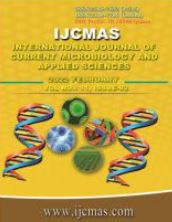


 National Academy of Agricultural Sciences (NAAS)
National Academy of Agricultural Sciences (NAAS)

|
PRINT ISSN : 2319-7692
Online ISSN : 2319-7706 Issues : 12 per year Publisher : Excellent Publishers Email : editorijcmas@gmail.com / submit@ijcmas.com Editor-in-chief: Dr.M.Prakash Index Copernicus ICV 2018: 95.39 NAAS RATING 2020: 5.38 |
Citrus greening (HLB) is deadly diseases caused due to gram negative bacterium called α-probacteria. The transmission of disease occurs by a vector psyllid (Diaphori citri). It cannot be controlled fully by chemical means only the production of diseases free panting material and removal of infected part are the measures to overcome this disease. The early detection of this disease helps to keep the orchards free of diseases and losses. On the basis of visual symptoms the diagnosis of HLB under field condition is very difficult. The symptoms occurred due to HLB are like blotchy mottle pattern of leaves and yellowing of leaves which can also be the reason of nutrient deficiency like zinc, manganese and iron. So, to avoid this confusion present study was designed to produce rapid diagnostic test for the disease. The Iodine kit method was standardized for the detection of disease in field with accuracy and rapidity. The HLB infected leaf produce high starch compare to healthy leaf because of that there is production of brown colour on reaction with iodine while yellow colour was observed in healthy leaves this shows the absence of HLB infection. Later the polymerase chain reaction (PCR) was used to confirm and validate the result obtain by iodine kit method using specific primer to 16S rDNA region of Indian ‘Ca. L. asiaticus’ i.e. OI1/OI2c species. The amplification was observed in HLB infected leaf at 600c with amplicon size of 1160 bp, which was absent in healthy leaf sample. Thus, the iodine kit method has great potential to provide an improved, cost effective, rapid, user friendly and in situ method for diagnosis of Ca. L. asiaticus’ for the farmer, nurseryman, mobile plant pathology laboratories, bud wood certification programme and quarantine programme and in offices. The present methods of disease diagnosis helps in the reduction of disease outbreak and keep the orchard free from diseases by helping us in the screening of disease free planning material.
 |
 |
 |
 |
 |